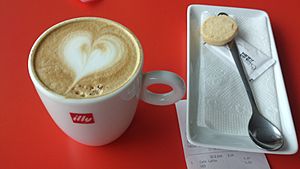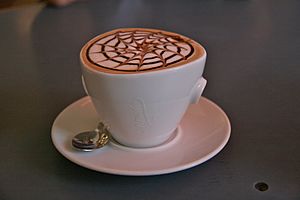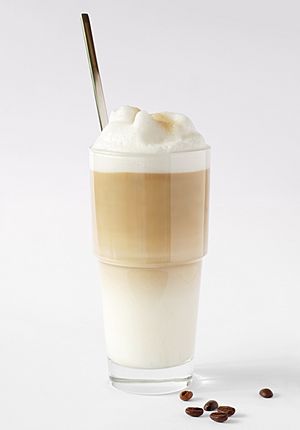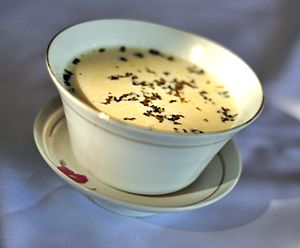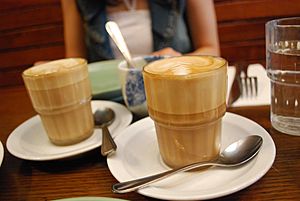Latte facts for kids
A latte is a popular type of coffee drink. It is made by mixing espresso (a strong coffee shot) with hot, steamed milk.
Contents
Where Lattes Come From
People have been mixing coffee and milk in Europe for a long time, since the 1600s! Drinks like caffè latte (Italian), Milchkaffee (German), and café au lait (French) were common at home, especially for breakfast.
The word caffè latte was first used in English in 1867. Some people believe the commercial latte drink we know today was first made in America.
In Italian, the word latte simply means "milk". So, if you order a "latte" in Italy, you might just get a glass of milk! In Spanish, people say café con leche, which means "coffee with milk."
The latte became very popular in Seattle, USA, in the 1980s and then spread widely in the 1990s. In many English-speaking countries, "latte" is a short way to say "caffelatte," which means "coffee and milk."
How Lattes Are Made Today
In Italy, people usually make caffè latte at home for breakfast. They use a special stovetop pot called a Moka pot to brew the coffee. Then, they pour it into a cup with hot milk. This milk is usually not foamed like the lattes you might get in a coffee shop.
Outside of Italy, a caffè latte is typically served in a glass or cup that holds about 240 mL (8 US fluid ounces). It usually has one or two shots of espresso. The rest of the cup is filled with steamed milk, and there's a thin layer of foamed milk on top, about 12 mm (0.5 inches) thick. In the US, lattes are often made very sweet by adding a lot of sugar.
A latte is similar to a cappuccino, but there's a key difference. A cappuccino has a thicker layer of milk foam, about 20 mm (0.8 inches) thick. Another similar drink is the flat white, which is popular in Australia and New Zealand. It's served in a smaller cup with very fine, micro-foamed milk.
Iced Lattes
An iced latte is a cool version of the drink. It's made with espresso and cold milk poured over ice. Unlike a hot latte, it doesn't have steamed milk or foam. Iced lattes often have sugar or flavored syrups added, like vanilla or caramel. Sometimes, they are even blended with ice to make a slushy drink.
Latte vs. Latte Macchiato
A caffè latte and a latte macchiato are different, even though they both have coffee and milk.
In a latte, you add milk to the espresso. This gives the latte a stronger coffee taste.
In a latte macchiato, it's the other way around: you add espresso to the milk. The milk is steamed to be very foamy and served in a glass. Then, a small amount of espresso is gently poured through the foamy top. This creates a layered drink with a "macchia," or "spot," of espresso on top. The word "macchiato" means "stained" in Italian, referring to the coffee "stain" in the milk.
Different Ways to Serve Lattes
- Lattes are often served in a glass on a small plate with a napkin. This helps you hold the glass if it's hot.
- Sometimes, lattes are served in a bowl, especially in Europe.
- Latte art is a popular way to make lattes look beautiful. Baristas (people who make coffee) pour steamed milk into the coffee in a special way to create patterns. These patterns can be hearts, flowers, or other simple designs.
- Iced lattes are sometimes served without stirring, so the dark coffee appears to float on top of the white milk.
- You can find lattes with different flavors added, like vanilla, chocolate, or caramel.
- In Asia and North America, lattes are sometimes made with teas instead of coffee. You might find chai lattes, matcha lattes (made with green tea), or royal milk tea lattes.
- For people who can't drink cow's milk or prefer not to, lattes can be made with plant-based milks like soy milk or oat milk. These milks can also be steamed and foamed like cow's milk.
Images for kids


